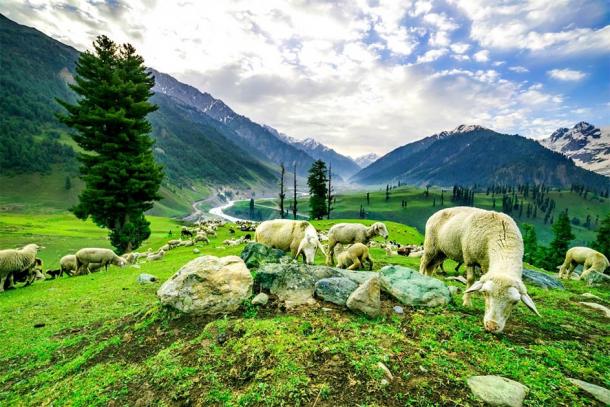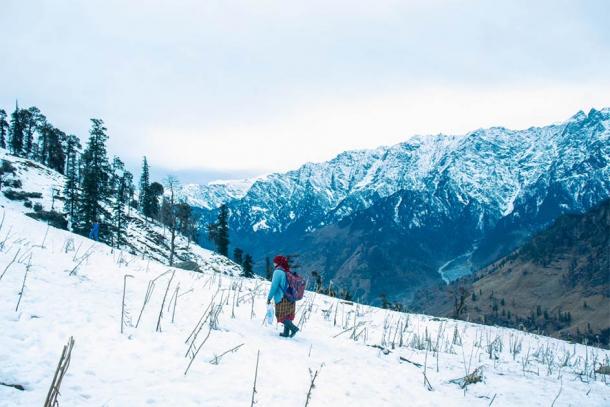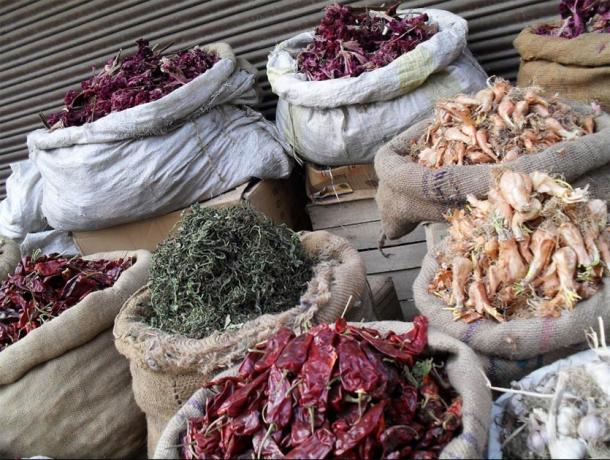During nineteenth and first-half-of-the-twentieth century, a popular proverb on every Kashmiri’s tongue was Sountas na keneras, Te hardas na neeles , meaning “plough the soil in spring even if it is sodden, and reap the standing crop in the autumn even if it is unripe.” Like a grand narrative, this age-old wisdom was taught to the younger generations. But, for the old and experienced it was repeated out of anxiety. The winter in Kashmir had taught them not to wait and watch, but to finish their work as early as possible. It was a lesson that was forged out of the experience of their ancestors. The arrival of heavy snowfalls always disconnected the Valley of Kashmir from the rest of the world, which explains why the winter in Kashmir was perceived as a calamity throughout history.

Every year in the Valley of Kashmir, spring would bring with it hope after the long months of winter. ( khlongwangchao / Adobe Stock)
The Coming of Spring in Kashmir
Every year, spring started with expedite and hope since winter had exhausted existing stocks. The slogan Yus karih gongul, Sui karih krao (meaning “He who ploughs shall reap”) echoed everywhere in order to catch convince peasants to initiate agricultural tasks early with zeal and zest. On the eve of gongul (meaning “tilling land”), sweets, nuts and almonds were distributed among the children to build confidence among the ploughmen and convey the message to every household that Alan chhuh phal, Tah nendan chhuh danih (translated as “ There is fruit to the plough and rice to the weeding”).
Before tilling, plough animals were allowed to fight in the fields to witness that the lethargic winter had gone and that the time for work and struggle had begun. The cheering, shouting and laughing of children was a sign that they too were enthusiastic. Soon, men and women were seen carrying spades, hoes and mallets to prepare the soil for planting. Once they had sown their seed, nend (“weeding”) was performed carefully by the most experienced sons of the soil.
Finally, in the expectation of a golden harvest, people would often bless one another with the saying Phalis hyul theh helis khar diyanai Khuda , meaning “May God bless your every seed to a sheaf and every sheaf to a kharwar” (ass-load). Due to the fact that a single crop was grown on a parcel of land, peasants were well aware that if their crop were to fail, they would have to suffer.

Woman walking through the Kashmir winter landscape. ( gajendra / Adobe Stock)
Autumn: Preparing for Winter in Kashmir
From the inception of spring, right up until the end of autumn, peasants would suffer the hardships of agricultural work in the hope that they would be able to avert a food crisis during winter and that their family would not starve. They welcomed Harud (autumn) with a sickle in hand and sacks on their shoulders, ready for a season of hard work.
The rewards for toiling the fields always proved to be below their expectations since a large share was taken by officials as tax revenue and much was distributed among the nangars (functional-classes) in exchange for their services. The remaining portion would always seem inadequate, and peasants would lament in sorrow: Sonth chhuh tshali, Tah harud chhuh bali (meaning “Spring, that passes immediately, is a trap, and autumn, that demands hard work but less output, is a futile exercise”).
Before the snowfall of winter in Kashmir began, families had to assure that their basic necessities, such as grain, fuel, fodder and vegetables, had been stored in bulk because winters were so ruthless that any communication or connectivity between relatives and neighbors was interrupted for months at a time. Grain was stored in a kuth (granary) that stood very close to the house. It was locked to protect their supplies, holes blocked to prevent rats and a small water channel was created so as to flow by its side in case the granary should catch fire.
Men were employed to guard granaries from thieves and were paid Prehdari (a guarding fee) . The demands of fuel, fodder and vegetables were largely managed by women, who were continually busy from the first day of spring managing the household affairs. To be self-reliant in terms fuel, cow-dung was dried for months and stored in the Kein (upper-story) of the house. Their supply was never sufficient, so women would be seen carrying baskets and roving behind herdsmen in the hopes of a handful of dung.
Leaves and twigs of trees, plants and bushes were swept, stored and burnt in the winter along with the dried dung to generate the flames of the hearth. Groups of women carrying food knotted in hankies were seen marching towards nearby forests to collect wood. Such wood was burnt to produce charcoal without which preparation of samavor–chai (a Kashmiri tea that was prepared in Kashmiri kettle called samavor) was impossible.

To last the Kashmiri winter, a novel method of drying vegetables and pulses called hokhseun was developed so that people could store them for the winter in Kashmir. ( Chinar Shade )
Preparing Food Stocks for the Harsh Kashmiri Winter
The idea that the snow-covered lands of Kashmir would produce vegetables and pulses in winter was a daydream. Preparing a stock of vegetables to last the winter was a most demanding task which required both time and patience. Only the agricultural families who planned well and consumed just half of their stocks in summer were able to store the rest for winter which would allow them to eat rice and vegetables during the endless Kashmiri winter. The shortage of vegetables can be gauged from the fact that rice, a luxurious and expensive food item, was exchanged by people from the plains for pulses produced by the Kandi (upper/hilly) people without any bargaining.
A novel method of drying vegetables and pulses was developed by the people of Kashmir called hokhseun (dry vegetables) so that they could store them for the winter. Their diet in winter included all kinds of grasses and herbs including haand, nunar, sochal, lisa, wopalhak, obeg, hadr, bumbh, kralmund, naramnor and more. As such, the upper-story of Kashmiri houses was found full of sacks and baskets holding dried pulses and vegetables. Even caves were dug and vegetables such as carrot, beetroot and turnip were stored in them in order to avert the shortage of vegetables.
Rearing cattle was a necessity because cattle supplied dairy items, dung, wool and they worked the plough. Thus, to sustain their animals through winter, a stock of fodder was a necessity. Keeping cattle had an important advantage as it also served as a response to the challenging chilliness of the winter. Cattle were not placed in a separate gaan (stable). Instead, the ground floor was reserved for the cattle and first floor for the family. In this way, cold winter nights were combated by making an opening on the first floor so that the warm breath of the cattle and sheep could ingress into the above floor and make it warm too.
The harshness of the winter was so severe that people often preferred to sleep with the cattle. Even valued guests, such as a son-in-law, were honored by placing their bedding on dangij (a wooden locker within a stable where sheep were penned) since it was the warmest place in the house. Cattle were the only room heating arrangement available during the winter. A proverb Yas wandas hammam tah retahkalih gav, sui ha-malih dunyahas aav (translating as “That man has come into the world, O father, who has got a warm bath for the winter and a cow for the summer”) depicts the yearning and suffering of the people who consider a person dead in the absence of a proper heating arrangement in the winter.
Desperate Times, Desperate Measures
Despite the countless preparations and cautionary tales, both humans and cattle suffered during the winter months, nor did they receive adequate nourishment. As such, starvation and a dearth of fuel were a permanent feature of the winter in the Valley of Kashmir. As the end of winter came closer, people would find their stores exhausted. Before the next harvest, there was no other option than to eat unripe fruits, grass and even nettle, thistle and walnut catkin.
Winter only lasted for certain months, but its psychological impact remained throughout year. People focused their attention on activities which would help them prepare for the long winter, and it was an endlessly tiring cycle. People were unable to save, and in the absence of savings, there were no investments, no profits and no growth at all.
These days, winter comes and goes and is viewed as just another season. People no longer consider it a calamity. Its harshness has been curtailed and its wrath defeated. Among the present generation, winter has found its place in the subconscious part of the mind. But, what happened during the last centuries that such a complex riddle has been solved?

Thanks to modern science, the harshness of winter was converted into romanticism. Now, adventurers from around the world visit Kashmir to enjoy winter trekking and sports. ( kistya / Adobe Stock)
What About Winters in Kashmir Today?
The food crisis has been resolved thanks to the green revolution which guaranteed a year-round supply of grain. The arrival of LPG and electricity were the miracles that solved the never-ending need of fuel for the winter. The invention of AC’s, heaters, geysers, electric-blankets, microwave-ovens and rice-cookers make it possible to cook and stay warm all year round, no matter the weather outside.
The construction of roads and tunnels that have connected Kashmir with the outside world have also worked wonders. Due to easy connectivity, contact with the marketplace means that in the midst of winter people can enjoy Italian food, buy a Chinese heater or even travel to the US. Adventurers from around the globe visit Kashmir to enjoy winter trekking and people from the different states of India yearn to participate in the winter games held annually at Gulmarg.
All this seems a mirage, if one looks through the lens of the past. But the solution to the problem of winter in Kashmir didn’t come overnight. With roots in modern science, the process of change began to take place over time, humiliating the remaining harshness of the winter. The adoption of science and technology have successfully altered the nature of winter, bringing with them the death of superstition and turning the yearly tragedy of winter into romanticism.
Top image: The arrival of heavy snowfalls always disconnected the Valley of Kashmir from the rest of the world, which explains why the winter in Kashmir was perceived as a calamity throughout history. Source: MirBasar / Adobe Stock
References
Lawrence, W. R. 1895 (2005). The Valley of Kashmir. New Delhi: Asian Educational Services.
Hinton Knowles, J. 1885. A Dictionary of Kashmiri Proverbs and Sayings. London: Trubner & Co.
Drew, F. 1875. The Northern Barrier of India, A Popular Account of the Jummoo and Kashmir Territories . London: Edward Stanford.
Munawar, N. and Shouq, S. 1992. Kashiri Adbuk Tawarikh . Srinagar: Kashmiri Department, University of Kashmir.
Akther Pandit, P. 2018. Peasantry and the Agrarian System in Kashmir: A Historical Perspective 1846-1885. Srinagar: Kashmir City Book Centre Pvt. Ltd.
 RSS Feed
RSS Feed















 December 19th, 2020
December 19th, 2020  Awake Goy
Awake Goy  Posted in
Posted in  Tags:
Tags: 













